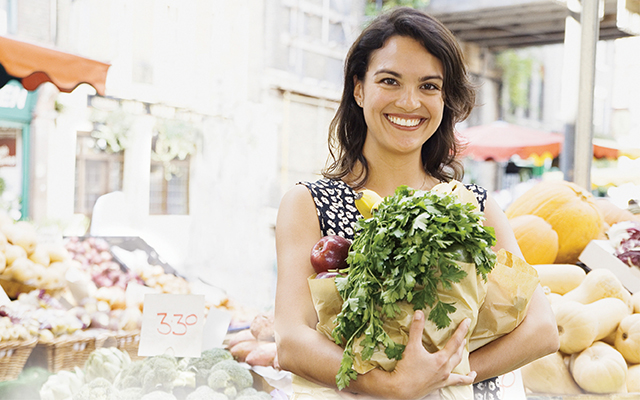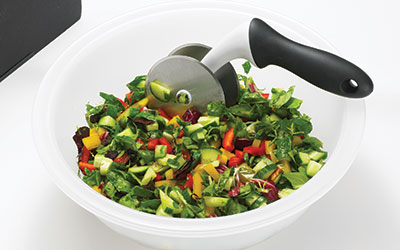The corn chip can’t see, but if it could, it would be eyeing you warily. It rests on the edge of your plate, while the conversation in your head goes like this:
“Don’t eat that — chips are full of fat and fat is bad for your arteries.” Another voice responds, “Come on, this chip’s organic. Plus, you’re allergic to wheat — you have to get your grains somewhere.” A third interrupts, “Corn is a monoculture! I thought you cared about the environment!” In the midst of your game of mental pinball, the chip disappears in a single gulp or goes to waste.
Michael Pollan, author of The Omnivore’s Dilemma: A Natural History of Four Meals, regards these sorts of protracted food debates as a symptom of a “national eating disorder” in which tradition, sustenance and pleasure no longer play a primary role in how we choose what to eat. Instead, “good food” is defined by numerous, often conflicting, sources — from the FDA and doctors to fad diets and industrial food companies.
Most of them encourage us to focus on isolated factors in our diets rather than on a broader view of food. This leads to chronic uncertainty about what to eat. Should we base our choices on calories, fat/carb/protein ratios or the glycemic index? How about cost and convenience? Can we afford to buy organics? Can we afford not to? What about the ethics and safety of factory-farmed foods? And what about the importance of buying local?
Perceived in this context, pleasure’s influence gets lost in the shuffle, or it gets transformed into “guilty pleasure” — one more reason to feel ambivalent about what we choose to bite, chew and swallow.
This splintered food perspective is also harming our personal and collective health. About 20 percent of deaths in the United States this year will be connected to some nutrition-related disease. And many of our nation’s air-, soil- and water-quality problems relate directly to our food-production methods. For example, agricultural runoff, which often contains herbicides and pesticides, accounts for more than 90 percent of river pollution in some states, according to the Environmental Defense Fund.
Clearly, our current approach is not serving us very well. But how do we tell the difference between good and bad in such a confused and confusing food landscape?
Fortunately there is a growing cadre of people — farmers, scientists, health advocates, food enthusiasts and ordinary “eaters” — who are working to restore our positive relationship with food. They’re making connections between food production and policy, nutrition, environmental health, and gustatory delight, and they’re showing that greater participation in our food system can lead to thriving health for our bodies and our communities. It can also make food choices a whole lot easier.
The Roots of Confusion
We live in a country where multiple crops thrive in abundance, so how did we get to the point where synthetic, processed foods abound? Or where type 2 diabetes, a disease related to obesity and poor nutrition, has come to affect almost 10 percent of the total adult population? Or where locating a fresh, whole-foods meal in a school cafeteria — an obvious site for educating our young about food — is an event akin to a Sasquatch sighting?
One reason is the complexity and density of the policies that determine food production, suggests Daniel Imhoff, author of Food Fight: The Citizen’s Guide to a Food and Farm Bill. The Farm Bill, for example, has become a massive piece of legislation that touches on everything from crop subsidies to animal welfare to energy policy (to name just a few) and which is renewed every five to seven years. The Farm Bill has become so big, writes Imhoff, that “it’s nearly impossible for any single person to really understand the full extent of what the Farm Bill actually covers.”
The language of food legislation is not designed to be citizen-friendly, and, historically, very few people have understood food policy.
What’s more, the language of food legislation is not designed to be citizen-friendly, and, historically, very few people have understood food policy. In her book What to Eat, Marion Nestle, PhD, MPH, nutritionist and New York University professor of nutrition, food studies and public health, argues that many industrial food producers would prefer we didn’t know too much about the intricacies of our food system, because if we did, we might actually buy less.
This is more than simple profiteering, she points out — these companies have a massive surplus of commodity-based food to unload on the cheap. In fact, there’s now enough food produced in the United States to provide 3,900 calories for every American, every day — almost twice what an adult needs.
The majority of these food surpluses come to us courtesy of outdated U.S. Farm Bill incentives, Pollan explains in an April 2007 New York Times article.
- The Farm Bill was originally built around post-Depression-era farm subsidies designed to keep storable crops growing and protect the national food supply.
- Problems arose when stockpiles grew beyond our needs, but subsidies stayed the same.
- The government then made the stockpiles cheaply available to industrial food producers, and they dispensed them to undernourished children in the school lunch program (among other places) — a solution that seemed innocent enough, but had far-reaching consequences.
Today, obesity far surpasses undernourishment as a problem for youngsters, but the caloric requirements for school lunches remain the same as when they were established to fight starvation after the Depression. As a result, school lunch programs serve up lots of cheap calories (including many highly processed items that weren’t around in the post-Depression era) — and very little high-quality food. Many experts suggest that this trains children to crave junk food from an early age. And that craving — combined with the lure of toys — writes Eric Schlosser in Fast Food Nation, sends some 90 percent of American kids between the ages of 3 and 9 to McDonald’s every month.
Pollan puts these paradoxes in simple terms: “The nation’s agricultural policies operate at cross-purposes with its public health objectives,” hence some of the understandable public confusion. The school lunch conundrum is one example. So are the acres of processed foods lining the center aisles of the supermarket. Our government’s food policy makes these nutritionally empty foods some of the cheapest, most convenient sources of calories available.
Fresh fruits and veggies are both more expensive and far less aggressively marketed than so-called junk foods.
Fresh fruits and veggies are both more expensive and far less aggressively marketed than so-called junk foods. A 2004 University of Washington study found that while a dollar can purchase 1,200 calories of cookies or chips, it buys only 250 calories of carrots. And a food company can’t add much value to a bunch of broccoli, Nestle points out, but they can add value to ultra-cheap corn when it’s combined with low-cost additives to make frozen apple strudel. This leaves consumers feeling stranded between practicality and health.
It also suggests that there are plenty of people who might eat more fresh food if they felt it was more affordable. And plenty of farmers might gladly grow a greater variety of fruits and vegetables if they could afford it, too — but only monoculture crops like corn, wheat and soybeans are subsidized.
While this research shows there’s an awful lot hidden in the glare of those blinding supermarket lights, it also suggests some easy things we can do to improve our food system from the ground up.
Imhoff’s definition of “citizen participation” is not limited to policy homework — we can also eat our way to a better system and better health. It’s mostly a matter of learning a few simple principles: Eat locally, eat simply, and eat for pleasure.
Keep It Close to Home
If you’ve ever noticed the difference between a summer tomato from your backyard and a winter one from another hemisphere, you know the best reason to eat locally is taste. Enjoyment is a huge incentive for food activist Sandor Ellix Katz, author of The Revolution Will Not Be Microwaved: Inside America’s Underground Food Movements . “I don’t think I am primarily motivated by ethics, per se, in my decisions of what to eat,” he says. “I feel like I’m motivated by, ‘Oh my God, that fruit on that tree is so fresh and succulent and delicious.’”
Plenty of additional benefits put this gratification into a larger perspective. Shopping for local foods at a farmers’ market makes it easy to eat more whole, fresh foods in season. You’re also directly supporting local growers who are competing with industrial food producers.
Alice Waters, food activist and founder of the legendary Berkeley, Calif., restaurant Chez Panisse, calls eating seasonally and locally a key part of a “delicious revolution,” and she’s not kidding. Fresh local food revolutionizes everything: our bodies, our social networks, our environmental health and our gastronomic pleasure.
The food we eat now travels as far as 3,000 miles from farm to plate.
According to the Leopold Center for Sustainable Agriculture at Iowa State University, the food we eat now travels as far as 3,000 miles from farm to plate. This produces significant amounts of pollution: A jet-transported pound of Hawaiian pineapple contributes 40 pounds of carbon dioxide to the atmosphere, while a pound of apples picked in your region doesn’t begin to approach that. What’s more, these shipment practices prevent us from knowing all we could about how the food was produced.
This can harm more than the environment. Unsafe foods from other countries can easily make their way onto our own plates because the U.S. government doesn’t require manufacturers to list the origins of ingredients on their products. So if a spice in your vegetable snack puffs came from a Chinese factory with infected equipment (the suspected cause of a salmonella outbreak in July that affected children in 19 states), you’re out of luck.
But when you shop at the local farmers’ market, you’ve eliminated the middleman, sharply reduced the use of transportation fuel, and been able to talk directly to the farmer about his or her growing practices. Your food suddenly has an accessible history — unlike the mysterious vacuum that surrounds a frozen TV dinner.
During the off-season, you can also find locally raised meats and produce at your food co-op or natural grocery. Produce managers love to chat about their sources, and most butchers in natural groceries are happy to give you the background on their meats — another place where switching to locally produced and grass-fed products can make a huge impact. Plenty of folks eat grass-fed beef for flavor and nutrition; others choose it because locally raised grass-fed cattle require only a third of the resources required to raise feedlot animals. Still others choose it because free-range grazing provides the healthiest and most humane environment for the animals.
And, as Barbara Kingsolver, Steven Hopp and Camille Kingsolver note in Animal, Vegetable, Miracle: A Year of Food Life, it doesn’t take much of an effort to have a major impact. “If every U.S. citizen ate just one meal a week (any meal) composed of locally and organically raised meats and produce,” they write, “we would reduce our country’s oil consumption by over 1.1 million barrels of oil every week. That’s not gallons, but barrels.”
This attitude is important to remember when it comes to buying organics, as well. If you decide to switch to organic milk, for instance, you’re supporting better land-use practices and your own better health — a 2005 Danish study found that organic milk had 75 percent more beta-carotene than its conventional counterpart. And you can avoid the health risks of pesticides and herbicides by opting for certified organic produce. (See “Eat Clean”.)
Finally, increasing our awareness of the social, environmental and health benefits of eating simply and locally can lead directly to a healthier metabolic relationship with your food. Time constraints and stress are two of the major factors that keep us harnessed to unhealthy eating patterns. When we feel conscious and satisfied enough about our food choices to slow down and eat reflectively, our bodies also become more capable of digesting the nutritional resources in our food.
Gut Wisdom
Proponents of a new food perspective emphasize the importance of developing a more conscious relationship with food. That involves cutting through the fog around our policies and production methods, but it doesn’t limit us to rigid protocols: They recommend we have more fun when we dine.
So-called slow-food advocates — including farmers, environmentalists and gourmands — are collectively working to restore people’s “sensoriality,” or sensual experience of their food, by encouraging them to slow down and taste it.
In Slow Food Nation: Why Our Food Should Be Good, Clean and Fair, slow-food pioneer Carlo Petrini argues that a lifetime of eating artificial flavors at high speeds can “confuse and atrophy our senses.” By contrast, a more deliberate relationship to buying, cooking and eating our food, as well as to the communal spirit of mealtime, causes us to want better foods, naturally. Once we’ve slowed down enough to experience the full lusciousness and subtlety of ripe, aromatic, peak-of-season fruits and vegetables; of carefully prepared whole grains and legumes; of responsibly raised, pasture-fed meats, we actually begin to crave them.
Once we’ve slowed down enough to experience the full lusciousness and subtlety of ripe, aromatic, peak-of-season fruits and vegetables; of carefully prepared whole grains and legumes; of responsibly raised, pasture-fed meats, we actually begin to crave them.
And here’s the beauty part: More and deeper food pleasure may just translate to less excess-weight trouble. Marc David, nutritionist and author of The Slow Down Diet, suggests that a rushed, automatic approach to eating not only deprives us of pleasure and comfort — it harms our metabolism. He notes that our level of intimacy with a sandwich is registered in the brain as the “cephalic phase digestive response,” or CPDR, which responds to the quality of our attention. It fluctuates based on whether we’re wolfing that sandwich while driving or savoring it on a park bench.
This “head phase” of digestion actually accounts for 30 to 40 percent of our nutrient absorption. So when we eat mindlessly, even the best foods are in some way wasted. But when we choose and eat our food consciously — a process amplified by a broader awareness of how it came to the table — we get maximum value and benefit from every bite.
Author and farmer Wendell Berry describes eating as ”an agricultural act.” This is another way of saying that each time we eat, we’re active creators of our own health, as well as the health of our community and our planet. There’s a lot of satisfaction that comes from reclaiming this power. And no small amount of confidence: Perhaps that little corn chip is not the boss of you after all.
How to Think Big(ger) About Food
Our culture’s current perspective on food choice is confused and confusing. But we can begin to transcend this morass by taking some simple steps. Here are a few ideas for getting started:
1. Buy directly from farmers. When you buy from a farmers’ market or CSA, the food growers get your entire food dollar, compared with the 19 cents they average from wholesalers. What’s more, eating direct-from-farm foods gives you a great introduction to seasonal eating: If there’s escarole or green beans available, it’s their peak time. And by the time they’re gone, the acorn squash will just be arriving.
2. Ask around. Get in the habit of asking restaurant servers and grocery-store staff where their food comes from. Is the chicken free-range? Is the lettuce local? When businesses learn that people are interested in the origins of food, they know there’s a payoff in caring about those issues, too.
3. Take a cooking class. Cooking is another easy way to become more aware of your food. If you’re mystified by anything more exotic than celery, a class can offer you some confidence-building basics about how to select and prepare a wide range of high-quality whole foods.
4. Write your senator. Our representatives have the power to change the way we eat from the ground up, especially when it comes to deciding the details of legislation like the U.S. Farm Bill. Write them, and let them know you’re interested in policies that support better growing practices, small farms and more nutritious crops.
5. Plant a garden. One of the best ways to gain an intimate relationship to your food is to grow some of it yourself. Even a few herbs in a window box can be a delicious way to educate yourself and your family about the food cycle.|




This Post Has 0 Comments